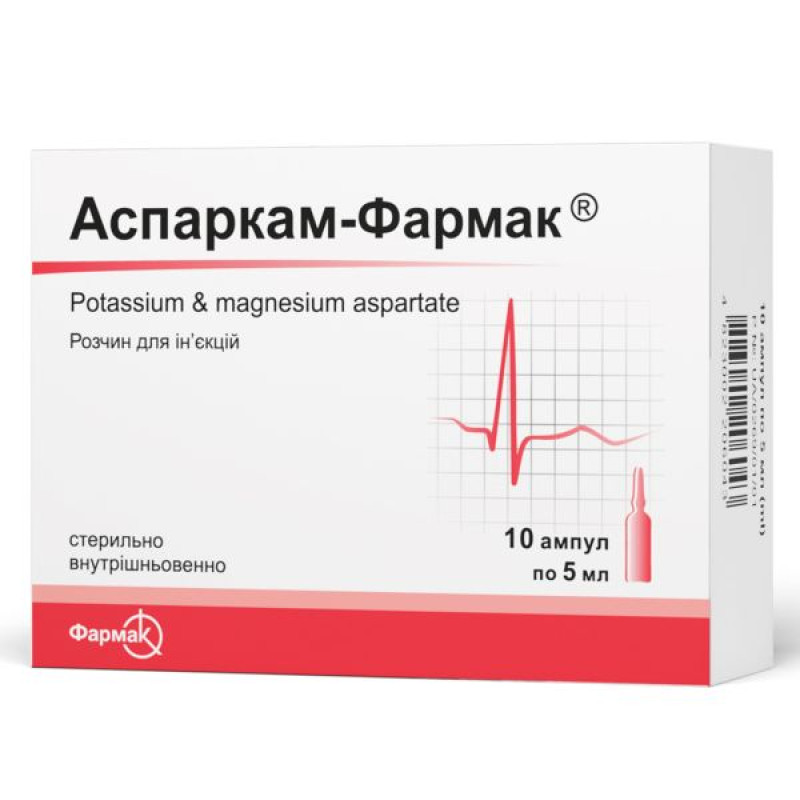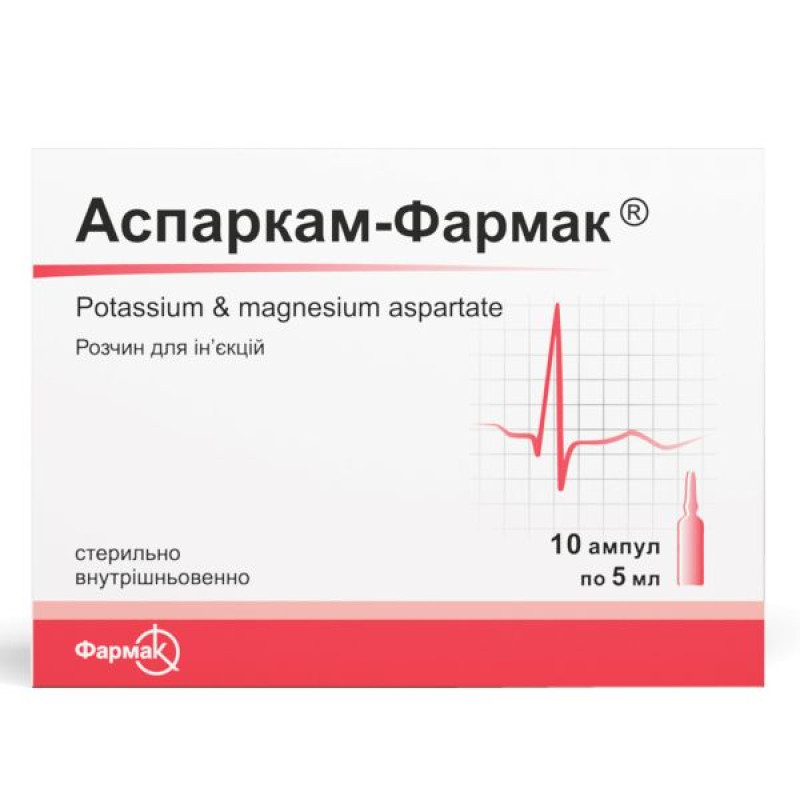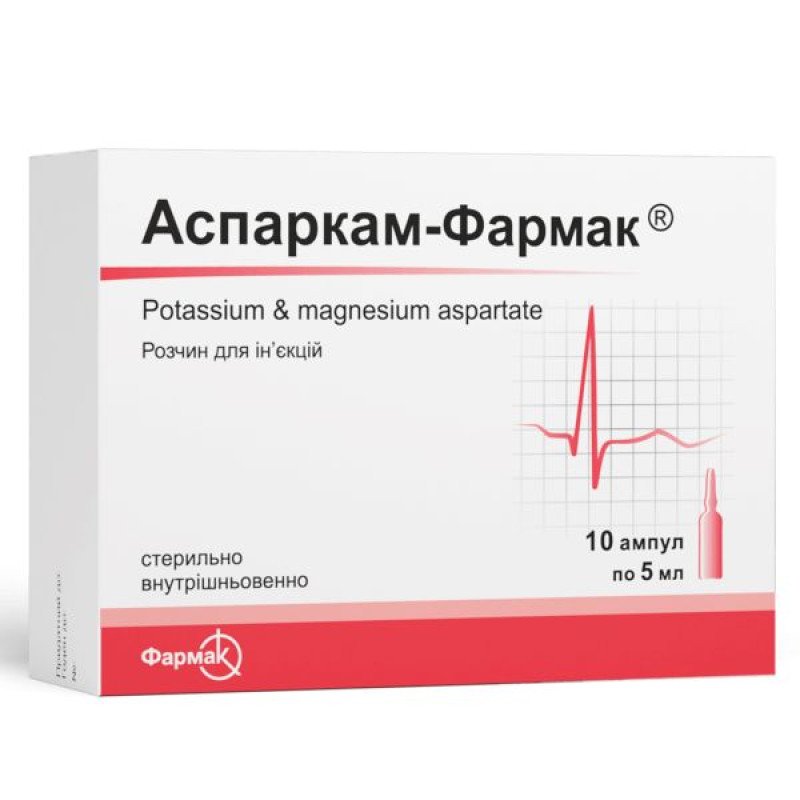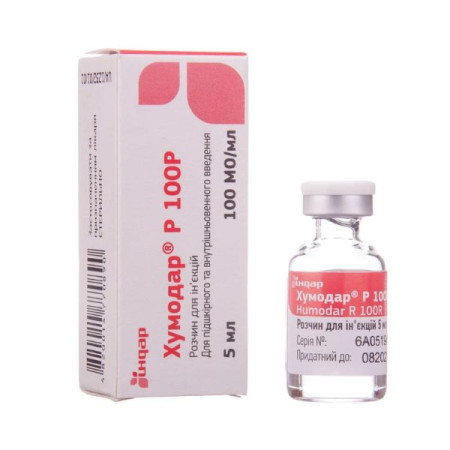Asparkam-Farmak solution for injection ampoule 10 ml No. 5

Instructions Asparkam-Farmak solution for injection ampoule 10 ml No. 5
Composition
1 ml of solution contains:
active ingredients: magnesium asparaginate 40 mg (3.37 mg magnesium), potassium asparaginate 45.2 mg (10.33 mg potassium);
excipients: sorbitol (E 420), water for injections.
Dosage form
Solution for injection.
Main physicochemical properties: clear colorless or slightly yellowish liquid.
Pharmacotherapeutic group
Mineral substances. Magnesium preparations.
ATX code A12C C30.
Pharmacological properties
Pharmacodynamics
The drug belongs to the group of drugs that regulate metabolic processes. Magnesium activates sodium-potassium ATPase, as a result of which the intracellular sodium content decreases and the influx of potassium into the cell increases. When the sodium concentration in the cell decreases, sodium-calcium metabolism in vascular smooth muscles is inhibited, which leads to their relaxation, potassium ions stimulate the synthesis of ATP, glycogen, proteins, acetylcholine; potassium and magnesium support the polarization of cell membranes. Asparaginate promotes the influx of ions into the cell and participates in energy metabolism. The antiarrhythmic effect is realized due to the ability of the drug to eliminate electrolyte imbalance, reduce myocardial excitability and conductivity.
Pharmacokinetics
Not studied.
Indication
– For additional therapy in chronic heart diseases (heart failure, post-infarction period), in heart rhythm disorders, primarily ventricular arrhythmias;
– additional therapy in the treatment of digitalis drugs.
Contraindication
– Hypersensitivity to the components of the drug;
– acute and chronic renal failure;
– Addison's disease;
– third-degree atrioventricular block;
– cardiogenic shock (BP 90 mm Hg).
Interaction with other medicinal products and other types of interactions
Concomitant use of the drug with potassium-sparing diuretics and/or ACE inhibitors, beta-blockers, cyclosporine, heparin, nonsteroidal anti-inflammatory drugs increases the risk of developing hyperkalemia.
Application features
Rapid administration may cause facial flushing.
With prolonged use of the drug, it is necessary to monitor the level of potassium and magnesium in the blood, as well as regular monitoring of electrolyte hemostasis indicators and ECG data.
Asparkam-Farmak®, as a drug containing potassium and magnesium, should be used with caution in patients with myasthenia gravis; in conditions that may lead to hyperkalemia, such as decreased renal function, acute dehydration, widespread tissue damage, in particular severe burns. In this category of patients, it is recommended to regularly examine the level of electrolytes in the blood serum.
Since the drug contains sorbitol, patients with hereditary fructose intolerance should not use this drug.
Use during pregnancy or breastfeeding
To date, no danger has been reported when using the drug in this category of patients.
Ability to influence reaction speed when driving vehicles or other mechanisms
The drug does not affect driving.
Method of administration and doses
The drug is intended for intravenous administration only. Adults Asparkam-Farmak® should be administered slowly intravenously by drip - 10-20 ml (the contents of the ampoule should be diluted in 50-100 ml of sterile 0.9% sodium chloride solution or 5% glucose solution). If necessary, the dose can be repeated after 4-6 hours. The drug is suitable for combination therapy.
The course of treatment is determined by the doctor.
Children: Experience with the drug in children is insufficient, so it should not be used in this age group of patients.
Overdose
Cases of overdose are unknown.
Given the ability of the kidneys to excrete large amounts of potassium from the body, increasing the dose of the drug can lead to hyperkalemia only if it is associated with an acute or severe impairment of potassium excretion.
The therapeutic index of magnesium is wide, and in the absence of renal failure, severe side effects are extremely rare.
In case of rapid intravenous administration, symptoms of hyperkalemia/hypermagnesemia may occur.
Symptoms of hyperkalemia: general weakness, paresthesias, bradycardia, paralysis. Extremely high plasma potassium concentrations can lead to death from cardiac depression, arrhythmia, or cardiac arrest.
Symptoms of hypermagnesemia: nausea, vomiting, drowsiness, hypotension, bradycardia, weakness, slurred speech, double vision. At very high plasma concentrations of magnesium, hyporeflexia, muscle paralysis, respiratory arrest and cardiac arrest may develop.
In case of overdose, it is necessary to cancel K+ -, Mg 2 +-aspartate and it is recommended to carry out symptomatic treatment (calcium chloride 100 mg/min intravenously, dialysis, if necessary).
Adverse reactions
With rapid intravenous administration of the drug, the possibility of symptoms of hyperkalemia should be taken into account, such as nausea, vomiting, diarrhea, paresthesias and/or hypermagnesemia, such as facial flushing, hyporeflexia, convulsions, feeling of heat, respiratory depression.
Expiration date
3 years.
Do not use the drug after the expiration date indicated on the package.
Storage conditions
Store in a place protected from light at a temperature of 15 °C to 25 °C.
Keep out of reach of children.
Incompatibility
Do not mix the drug with other medicines, except for the solvents specified in the "Method of administration and dosage" section.
Packaging
5 ml or 10 ml or 20 ml in an ampoule. 10 ampoules in a pack.
5 ampoules in a blister. 2 blisters in a pack.
Vacation category
According to the recipe.
Producer
JSC "Farmak".
Location of the manufacturer and its business address
Ukraine, 04080, Kyiv, Kyrylivska St., 74.
There are no reviews for this product.
There are no reviews for this product, be the first to leave your review.
No questions about this product, be the first and ask your question.






